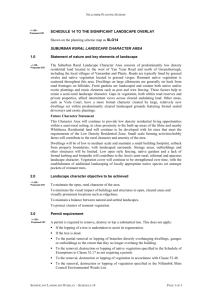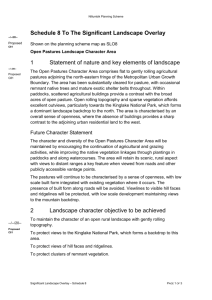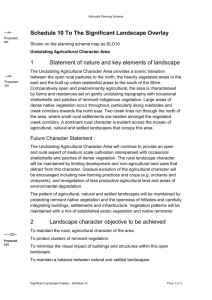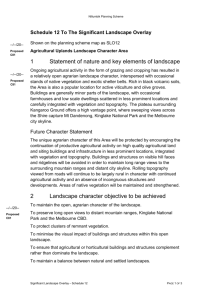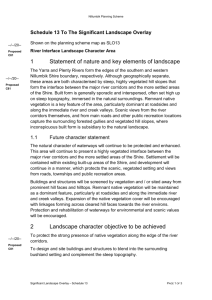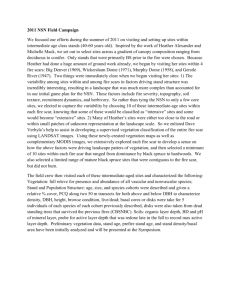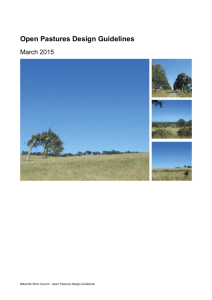Proposed C81 - Nillumbik Shire Council
advertisement
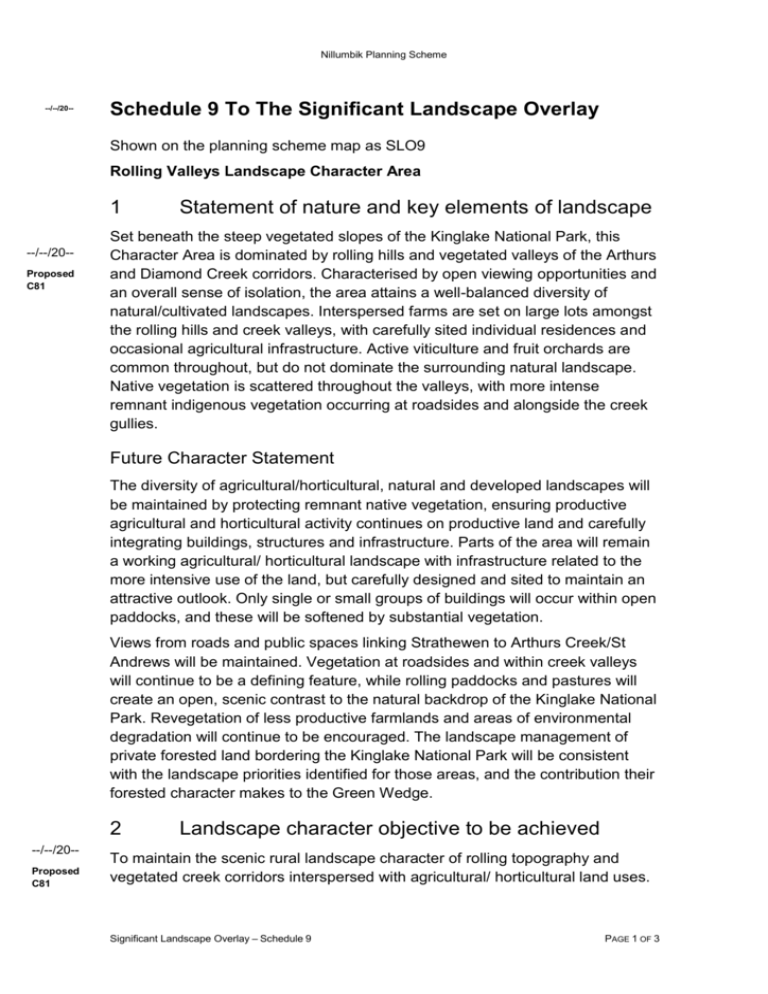
Nillumbik Planning Scheme --/--/20-- Schedule 9 To The Significant Landscape Overlay C81 Shown on the planning scheme map as SLO9 Rolling Valleys Landscape Character Area 1 --/--/20-Proposed C81 Statement of nature and key elements of landscape Set beneath the steep vegetated slopes of the Kinglake National Park, this Character Area is dominated by rolling hills and vegetated valleys of the Arthurs and Diamond Creek corridors. Characterised by open viewing opportunities and an overall sense of isolation, the area attains a well-balanced diversity of natural/cultivated landscapes. Interspersed farms are set on large lots amongst the rolling hills and creek valleys, with carefully sited individual residences and occasional agricultural infrastructure. Active viticulture and fruit orchards are common throughout, but do not dominate the surrounding natural landscape. Native vegetation is scattered throughout the valleys, with more intense remnant indigenous vegetation occurring at roadsides and alongside the creek gullies. Future Character Statement The diversity of agricultural/horticultural, natural and developed landscapes will be maintained by protecting remnant native vegetation, ensuring productive agricultural and horticultural activity continues on productive land and carefully integrating buildings, structures and infrastructure. Parts of the area will remain a working agricultural/ horticultural landscape with infrastructure related to the more intensive use of the land, but carefully designed and sited to maintain an attractive outlook. Only single or small groups of buildings will occur within open paddocks, and these will be softened by substantial vegetation. Views from roads and public spaces linking Strathewen to Arthurs Creek/St Andrews will be maintained. Vegetation at roadsides and within creek valleys will continue to be a defining feature, while rolling paddocks and pastures will create an open, scenic contrast to the natural backdrop of the Kinglake National Park. Revegetation of less productive farmlands and areas of environmental degradation will continue to be encouraged. The landscape management of private forested land bordering the Kinglake National Park will be consistent with the landscape priorities identified for those areas, and the contribution their forested character makes to the Green Wedge. 2 --/--/20-Proposed C81 Landscape character objective to be achieved To maintain the scenic rural landscape character of rolling topography and vegetated creek corridors interspersed with agricultural/ horticultural land uses. Significant Landscape Overlay – Schedule 9 PAGE 1 OF 3 Nillumbik Planning Scheme To protect views to the Kinglake National Park which forms a backdrop to this area. To maintain the visual prominence of the forested ranges. To site and design buildings and structures so that they appear as minor parts of the landscape. To retain areas of native vegetation, particularly along roadsides and creek corridors. To ensure that agricultural or horticultural buildings complement rather than dominate the landscape. To preserve the overall sense of isolation that is created through the natural topography and clusters remnant vegetation. Significant Landscape Overlay – Schedule 9 PAGE 2 OF 3 Nillumbik Planning Scheme 3 --/--/20-Proposed C81 Permit requirement A permit is required to remove, destroy or lop a substantial native tree. This does not apply: If the lopping of a tree is undertaken to assist its regeneration. If the tree is dead. To the partial removal or lopping of branches directly overhanging dwellings, garages or outbuildings to the extent that they no longer overhang the building. To the removal, destruction or lopping of native vegetation specified in the Schedule of Exemptions to Clause 52.17 as not requiring a permit. To the removal, destruction or lopping of vegetation in accordance with Clause 52.48. To the removal, destruction or lopping of vegetation specified in the Nillumbik Shire Council Environmental Weeds List. A permit is not required to construct a building or construct or carry out works for: An alteration or extension (including an outbuilding normal to a dwelling) to an existing dwelling or building used for agriculture provided all of the following are met: The height of the alteration or extension is less than 7 metres above the natural ground level; The alteration or extension is located at least 5 metres from the base of any substantial native tree; The floor area of the alteration or extension to an existing dwelling is less than 50 percent of the gross floor area of the existing building or 100 square metres, whichever is the lesser; The floor area of the alteration or extension to an existing outbuilding or building used for agriculture is less than 10 percent of the gross floor area of the existing building or 100 square metres, whichever is the lesser; The external surfaces, including roofs and walls, of the alteration or extension are clad and maintained in non-reflective materials coloured in muted tones; The top of the roof line of the alteration or extension is lower than the top of the ridgeline located directly behind the site of the extension or alteration. Significant Landscape Overlay – Schedule 9 PAGE 3 OF 3 Nillumbik Planning Scheme A new building used for agriculture provided all of the following are met: The height of the building is no more than 7 metres above the natural ground level; The building is located on land with a slope of no more than 1 in 5; The floor area of the building is no more than 100 square metres; The building is setback at least 5 metres from the base of any substantial tree; The building is setback 100 metres from a Road Zone Category 1 or 20 metres from any other road; The top of the roof line of the alteration or extension is lower than the top of the ridgeline located directly behind the site of the extension or alteration; and The external surfaces, including roofs and walls, of the building are clad and maintained in non-reflective materials coloured in muted tones. A horticultural structure provided all of the following are met: The external surfaces, including roofs and walls of the horticultural structure are clad and maintained in non-reflective materials coloured in muted tones; The horticultural structure is located at least 5 metres from the base of any substantial tree; The horticultural structure is setback 100 metres from a Road Zone Category 1 or 20 metres from any other road; and The top of the roof line of the horticultural structure is lower than the top of the ridgeline located directly behind the site of the horticultural structure. A permit is required to construct a fence. This does not apply to: Open post and wire fences of less than 1.2 metres in height. Post and mesh wire rabbit proof fences of less than 1.2 metres in height. Temporary fencing for construction sites. Transparent safety fence for a swimming pool located in the immediate vicinity of the swimming pool. A permit is required for earthworks that comprise more than 1 metre cut or fill. Significant Landscape Overlay – Schedule 9 PAGE 4 OF 3 Nillumbik Planning Scheme Meaning of terms For the purpose of this clause a ‘substantial tree’ means a tree that has a diameter at breast height (DBH) greater than 0.16 m at 1.4m above the ground. For the purpose of this clause a ‘horticultural structure’ means a structure, which provides a controlled growing environment for horticulture or plant nursery use, including plastic igloos, shade houses and glasshouses. 4 --/--/20-Proposed C81 Application requirements An application must be accompanied by a landscape plan showing proposed landscape works and plantings. 5 Decision guidelines --/--/20-Proposed C81 Before deciding on an application, the responsible authority must consider, as appropriate: Vegetation and Landscaping The type, extent, quality and significance of any tree to be removed. The extent and type (species) of new planting. The extent to which the proposed landscaping screens buildings and structures viewed from road corridors and public land. The extent to which the siting of the proposed buildings and works has minimised the need for the removal of native vegetation. Views and Vistas Whether the proposed development will maintain views from public land and road reserves towards hill faces and ridgelines. Whether the proposed development will maintain views of Kinglake National Park. The cumulative impact of all buildings and works visible from road reserves and public land on the landscape character of the area. Buildings and Structures The extent to which the development follows the natural topography of the land and minimises the need for earthworks. The prominence of the building along ridgelines, hill faces and elevated areas when viewed from a road reserve or public land. The setback of the building from property boundaries, river and creek corridors and roads. Significant Landscape Overlay – Schedule 9 PAGE 5 OF 3 Nillumbik Planning Scheme The scale, massing and roof form of the building. Whether the proposed development sits below the existing tree canopy. Whether the proposed development utilises non-reflective materials coloured and maintained in muted tones that are consistent with the natural setting. The location and siting of tennis courts. Rural Buildings and Structures The scale and siting of the proposed buildings and structures. Whether the proposed development utilises non-reflective materials coloured and maintained in muted tones that are consistent with the natural setting. Fencing, Access and Driveways The height and materials used to construct any proposed fencing. The extent to which roads, access tracks, driveways and car parking areas conform with the topography and maintain vegetation as a screen. The materials used to construct the proposed road base, access track or driveway. 6 Reference Documents --/--/20-Proposed C81 Nillumbik Landscape Character Assessment (Planisphere, 2009). Rolling Valleys Design Guidelines (Nillumbik Shire Council, March 2015) Significant Landscape Overlay – Schedule 9 PAGE 6 OF 3
